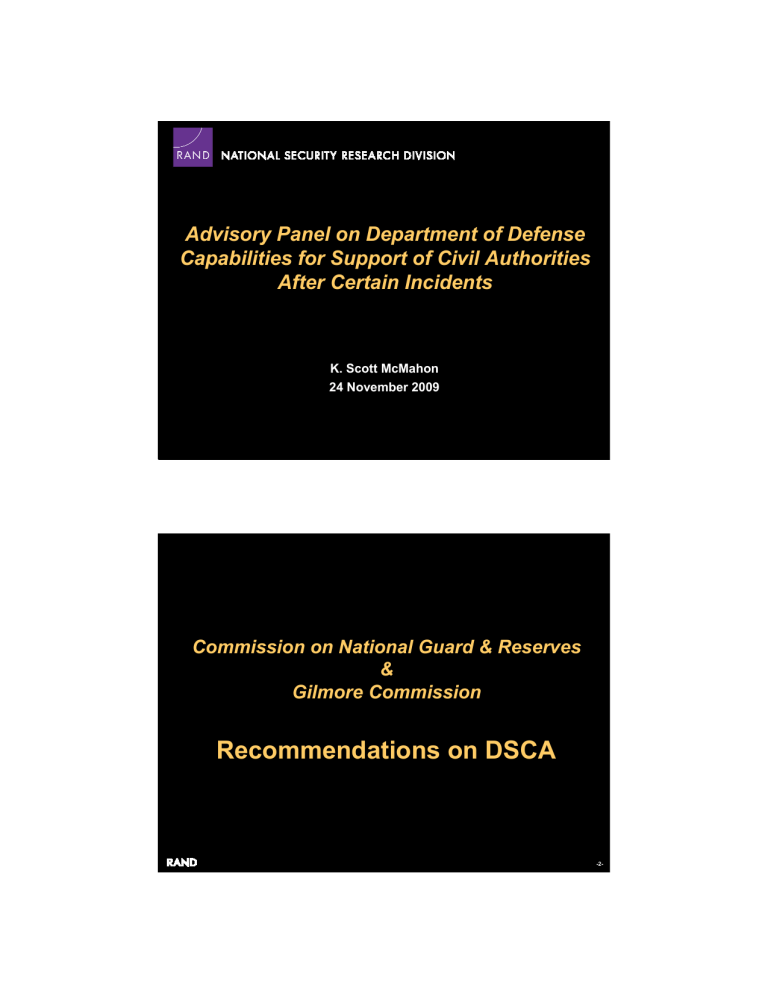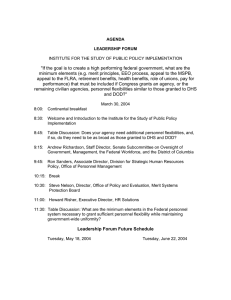Advisory Panel on Department of Defense After Certain Incidents

Advisory Panel on Department of Defense
Capabilities for Support of Civil Authorities
After Certain Incidents
K. Scott McMahon
24 November 2009
Commission on National Guard & Reserves
&
Gilmore Commission
Recommendations on DSCA
-2-
Commission on National Guard & Reserves
• Established by Congress NDAA FY05
• Arnold L. Punaro, Chairman
• Recommend changes in law and policy to ensure
NG&R are organized, trained, equipped, compensated, and supported to best meet U.S. national security requirements
• Reports issued March 2007 & January 2008
-3-
CNGR 2007 (1)
• DoD should program and budget (P&B) for civil support
• Status – Open
– SecDef reviewing civil support P&B policy
– DoD does P&B for capabilities required by law (e.g.,
CSTs) or policy (e.g., NG CERFPs)
– NDAA08 directs DoD/DHS to ID and DoD to fund
“military unique” capabilities for incident response
• Discussion
– No formal P&B process for civil support only
•
• DSCA is not DoD’s primary mission
State & Fed civil support needs not defined
– Current P&B process for civil adequate?
– DoD explicitly P&B for civil support?
– Should State requirements inform DoD civil support P&B?
-4-
CNGR 2007 (2)
• DHS and DoD (incl. NGB) exchange representatives to improve awareness, planning, training, exercising, requirements generation
• Status – Open
– 2004 DoD-DHS MOA under review & revision
– ~150 DoD (Active, Guard, Reserve, civilian) detailed to DHS currently
– Zero DHS at DoD (says OASD/HD)
• Discussion
-5-
CNGR 2007 (3)
• DoD develop protocols to allow governors to direct (e.g., via dual-status, OPCON or TACON) the efforts of Federal military assets responding to an emergency
• Status – Open
– Jan’09 SecDef authorizes “direct liaison” coordinating relationship and study of “dual-status” command
– DIRLAUTH permits T10 forces to coordinate with and respond to State authorities (incl. NG) for unity of effort
• Discussion
– CNGR finds incorrectly that 3 USC Sec 301 authorizes
State control of Federal military
– DoD has authorized dual-status for preplanned events with limited T10 presence
-6-
CNGR 2008 (1)
• Authorize involuntary mobilization of Federal RC during or in response to imminent natural or manmade disasters
• Status – Open
– 10 USC Sec 12304 amendment proposed by
DoD but not adopted
• Discussion
– Governors demand restraint on access to RC
– RC can be mobilized for WMD or terrorist attack
-7-
CNGR 2008 (2)
• Congress mandate that NG and Reserves have the lead role in and form the backbone of DoD operations in the homeland
• Status – Open
– DoD evaluating AC & RC roles and missions
• Discussion
– Combatant commanders need flexibility to call on DoD-wide resources
-8-
Gilmore Commission
• Advisory Panel to Assess Domestic Response
Capabilities for Terrorism
• Established by Congress NDAA FY99
• Gov. James S. Gilmore, Chairman
• Conducted in-depth threat assessment
• Offered programmatic and functional recommendations for national strategy for combating terrorism
• Issued five reports 1999 to 2003
-9-
Gilmore Commission 2001 (1)
• Military departments institute specific training in military units most likely to be involved in civil support
• Status – Partially implemented
– CBRNE units trained for DSCA (CCMRF, CBIRF,
CST, CERFP)
– Not clear that all units likely to be involved receive specific training
• Discussion
– We are reviewing CONPLANs and OPLANs for associated unit types or specified units
-10-
Gilmore Commission 2002 (2)
• NORTHCOM have operational control of all Federal military forces engaged in missions within the
Command’s area of responsibility for support to civil authorities
• Status – Substantially implemented
– NORTHCOM typically supported commander
– Supporting commanders will likely still control forces under their purview (e.g., TRANSCOM &
SOCOM)
• Discussion
-11-
Gilmore Commission 2002 (3)
• Commander NORTHCOM have dedicated rapid reaction units with a wide range of response capabilities for
DSCA in the event of a terrorist attack
• Status – Partially implemented
– CCMRF allocated but doesn’t have full range of recommended capabilities
– GC offered capability examples: quarantine support, support to crowd control activities, CBRNE detection and decontamination, emergency medical response, engineering, communications, support to law enforcement
• Discussion
-12-
Gilmore Commission 2002 (4)
• SecDef collaborate with State Governors to develop agreed lists of National Guard civil support activities for which the DoD will provide funds
• Status – Partially implemented
– Agreed lists for civil support not developed
– T32 Sec. 901-908 authorize DoD to fund certain
National Guard HD activities
• Discussion
-13-
Gilmore Commission 2002 (5)
• SecDef direct that certain National Guard units be trained for and assigned homeland security missions as their exclusive missions
• Status – Not implemented
• Discussion
– GC wanted capability beyond CSTs
-14-




